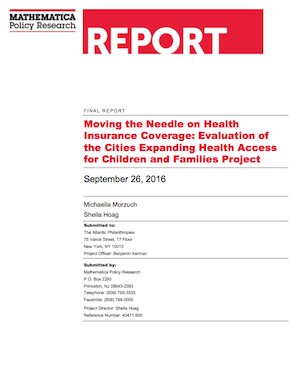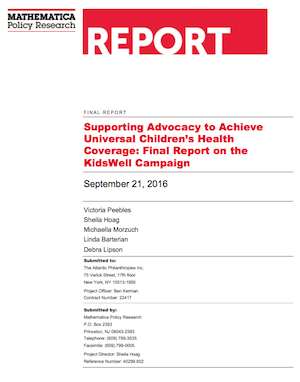What We’ve Learned: Helping Remaining Uninsured Obtain Health Coverage
Resource type: News
Georgetown Center for Children and Families | [ View Original Source (opens in new window) ]

By Benjamin Kerman and Annmarie Benedict, The Atlantic Philanthropies
It’s been almost three years since the Affordable Care Act (ACA) went into full effect. During that time, 13 million people gained health insurance coverage. With open enrollment starting tomorrow, communities have another opportunity to extend the ACA’s benefits to the estimated 29 million Americans who remain uninsured. Among them are 4 million kids who are at risk for delayed or inadequate care because they still lack basic health coverage.
Our efforts to do better will be advanced through understanding and action. Who are these children and where do they live? Children who are uninsured are still concentrated in low-income families. Children living in households with income below $25,000 have an uninsured rate of 7.5 percent, more than twice those in high-income households (those with income at or above $100,000). Black and Hispanic children are more likely to lack insurance than those who are white or Asian. Nearly forty percent of all uninsured children live in just three states—Texas, California, or Florida—and as a percentage of children in the state, more than 10 percent of children in Alaska, Arizona, and Texas remain uninsured.
States and cities facing up to their responsibilities can lead the way. It’s not easy to reach the families of these children, nor to give them the information and help they need to sign up their kids for health insurance. But we know certain strategies work better than others. Through grants to national and state advocacy organizations and city-sponsored coalitions, Atlantic Philanthropies has learned that it takes “boots-on-the-ground” outreach and enrollment efforts. The most successful projects formed strong community partnerships among city government agencies, public health departments, school systems, and community-based organizations with roots in low-income neighborhoods. It also helps when application systems made it simple to enroll. States that expanded Medicaid coverage to low-income adults are also more likely to sweep children into the coverage net.
Innovation opens new paths to increase coverage but neither new approaches nor application of validated strategies under new conditions guarantee success. Frequent checks to see what works, and what does not, can guide us forward. Communities participating in an outreach and enrollment project sponsored by Atlantic that collected data on all of their outreach and enrollment efforts had real-time information to indicate which efforts were effective, or whether they should try something else. For example, in Garden City, Michigan, the city’s initial outreach strategy of providing school-based outreach and enrollment at parent-teacher conferences did not lead to the anticipated “flood” of people interested in information nor an expected increase in enrollment appointments. Similarly, the team in Hattiesburg, Mississippi also expected schools to be their primary source for accessing children and families, but they also found a low response to school-based outreach efforts. As a result, both cities shifted efforts, until they found strategies that worked in their cities. In Garden City, the team had success when they included inserts about health insurance with the city’s water bill mailings. In Hattiesburg, the team found success by providing enrollment assistance at centers for the Special Supplemental Nutrition Program for Women, Infants, and Children (WIC).
Advocates working to change state policy must also pivot in response to changes in the political landscape. For example, in 2011, Mississippi-based advocates sponsored by Atlantic supported a state-based exchange and Medicaid expansion for low-income adults, believing both would benefit many impoverished Mississippians. Although substantial progress was made on the state-based exchange throughout 2011, when a new governor took office in January 2012, he made it clear he would not implement any aspects of the ACA. Realizing the time was not ripe for ACA implementation, the advocates shifted gears, focused their resources on eliminating any bureaucratic or administrative barriers in Medicaid and CHIP, in order to make it easier for families eligible for these public coverage options to enroll or renew their coverage.
Decades of experience conducting campaigns to enroll poor children in Medicaid and CHIP programs have shown the importance of ongoing outreach. We need to transfer that experience to campaigns to help families enroll in health insurance exchanges, so they can qualify for subsidies that help them afford coverage for parents and their children. As we get ready for the upcoming open enrollment that begins November 1st, state and local governments, schools, community organizations, and advocates must come together to ensure no child goes without coverage. Two new resources (see below) from Mathematica Policy Research, made possible by Atlantic’s support, can help people in every state and community design outreach strategies that work.
Read the Reports


Benjamin Kerman is Head of Strategic Learning and Evaluation and Annmarie Benedict is Senior Program Executive & Director of Grants Monitoring at The Atlantic Philanthropies.
Mathematica Policy Research and the Georgetown Center for Children and Families are Atlantic grantees.